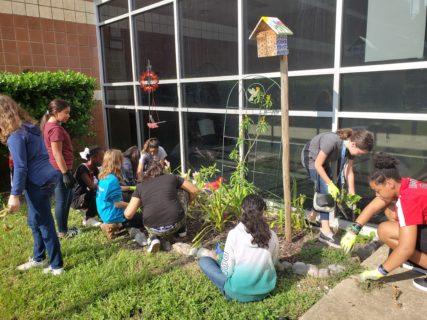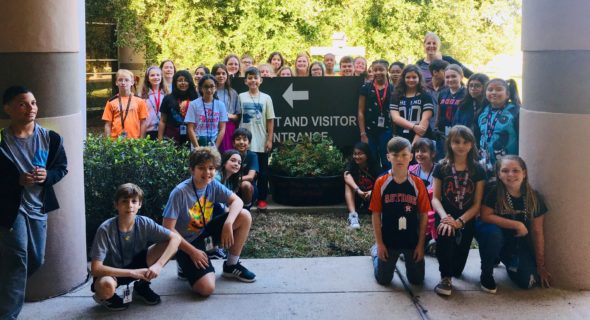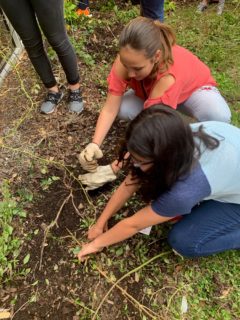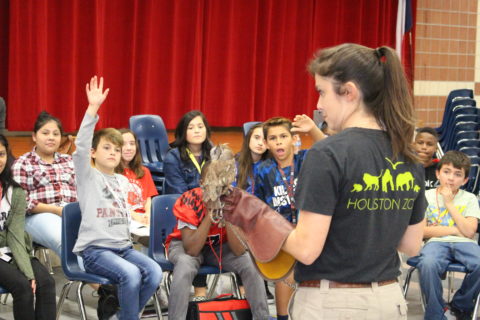Saving Wildlife Through Pollinator Pathways at Space Center Immediate School
 The Houston Zoo offers several school partnerships for children and schools to participate in. The Houston Zoo School Partnership Program forms relationships with Houston area schools by connecting them with wildlife saving actions. The Pollinator Garden Partnership is one of the many programs created by the Zoo, for schools to help save pollinators like butterflies, bees, hummingbirds, and other pollinating insects and wildlife by connecting students with local wildlife found within their school yards. The program engages students in nature by focusing on establishing native gardens around school communities.
The Houston Zoo offers several school partnerships for children and schools to participate in. The Houston Zoo School Partnership Program forms relationships with Houston area schools by connecting them with wildlife saving actions. The Pollinator Garden Partnership is one of the many programs created by the Zoo, for schools to help save pollinators like butterflies, bees, hummingbirds, and other pollinating insects and wildlife by connecting students with local wildlife found within their school yards. The program engages students in nature by focusing on establishing native gardens around school communities.
Space Center Intermediate school is one of the many schools active in the Partnership Program. DeAndra Ramsey, a coordinator for school programs, oversees approximately 20 schools within the Partnership Program across the Houston area. This student-led program takes place throughout the school year, giving students an opportunity to learn about local wildlife.
 In addition to the School Partnership program, the Space Center school is a part of the Prairie Pollinator Pathways, a segment of the Staff Conservation Fund Grant. The Staff Conservation fund enables staff members to provide support to other staff to carry out wildlife-saving projects. This is currently the only school that is funded by the grant, due to the school’s location along pathways in the Clear Lake area. The Prairie Pollinator Pathways works with the school’s garden club; making it a completely voluntary program averaging between 30-50 students each visit.
In addition to the School Partnership program, the Space Center school is a part of the Prairie Pollinator Pathways, a segment of the Staff Conservation Fund Grant. The Staff Conservation fund enables staff members to provide support to other staff to carry out wildlife-saving projects. This is currently the only school that is funded by the grant, due to the school’s location along pathways in the Clear Lake area. The Prairie Pollinator Pathways works with the school’s garden club; making it a completely voluntary program averaging between 30-50 students each visit.
 Since joining the program in 2018, Space Center Immediate has done tremendous work around their community. Ramsey begins the school year with a kick-off event to discuss the program and its many benefits to the ecosystem. These actions are being championed by the students. During the 2018 school year, Space Center students established gardens around their school and have performed routine maintenance and upkeep for the gardens. This year, the students have installed above ground planters in the walkways, so parents and families can be properly welcomed into the school. They have also begun seeding out the backfields of the school to make room for a garden later this year.
Since joining the program in 2018, Space Center Immediate has done tremendous work around their community. Ramsey begins the school year with a kick-off event to discuss the program and its many benefits to the ecosystem. These actions are being championed by the students. During the 2018 school year, Space Center students established gardens around their school and have performed routine maintenance and upkeep for the gardens. This year, the students have installed above ground planters in the walkways, so parents and families can be properly welcomed into the school. They have also begun seeding out the backfields of the school to make room for a garden later this year.
Because the program is completely student-driven, it’s important for the students to understand how their participation and contribution to the program are reducing threats to wildlife in a concrete way. Students learn the numerous benefits of a pollinator garden and how it can benefit wildlife. Ramsey also focuses on the importance of native Texas plants and the animals that benefit from them, such as screech owls, snakes, and turtles. The kick-off event features ambassador animals that can benefit from these specific pollinator gardens, providing more motivation for the students to help save wildlife. It’s important to showcase the biodiverse ecosystem we live in while also creating spaces for these animals to thrive in.
 Students are also provided with tips to create these gardens in their own backyards. Pollinator gardens can make a big impact regardless of the size. The Staff Conservation Fund grant is creating these steppingstones in the Clear Lake area because of the good spaces already available. The Space Center school is a steppingstone for these pollinators to continue to thrive in that area.
Students are also provided with tips to create these gardens in their own backyards. Pollinator gardens can make a big impact regardless of the size. The Staff Conservation Fund grant is creating these steppingstones in the Clear Lake area because of the good spaces already available. The Space Center school is a steppingstone for these pollinators to continue to thrive in that area.
You can help save animals in the wild by creating your own pollinator-friendly garden at home. Download this plant shopping guide to help get you started.
